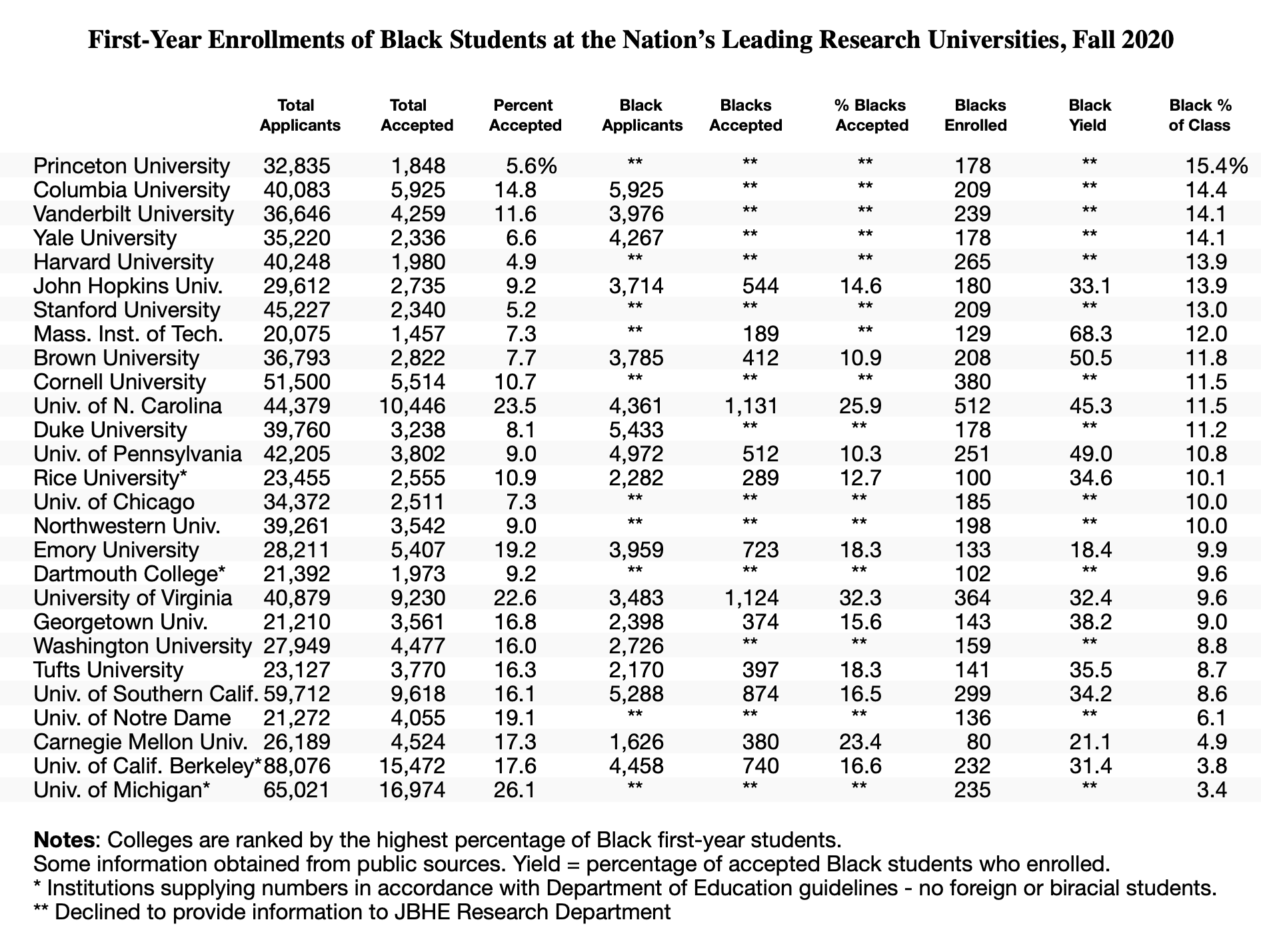![]() Once again, this year The Journal of Blacks in Higher Education has completed its survey of admissions offices at the nation’s highest-ranked research universities. For the 28th consecutive year, we have calculated and compared the percentages of Black/African-American students in this fall’s entering classes. As in the past, our survey publishes information on the total number of Black applicants at the various institutions, their acceptance rates, enrollment numbers, and yield rates (the percentage of students who eventually enroll in the colleges at which they were accepted).
Once again, this year The Journal of Blacks in Higher Education has completed its survey of admissions offices at the nation’s highest-ranked research universities. For the 28th consecutive year, we have calculated and compared the percentages of Black/African-American students in this fall’s entering classes. As in the past, our survey publishes information on the total number of Black applicants at the various institutions, their acceptance rates, enrollment numbers, and yield rates (the percentage of students who eventually enroll in the colleges at which they were accepted).
Black Students in the Class of 2024
For nine years in a row, Columbia had the highest percentage of Black first-year students among the highest-ranking universities in the nation. Four years ago, Columbia finished in a virtual dead heat for first place but was narrowly edged out by Washington University for the top spot. Again in 2017, Columbia finished in second place with an entering class that was 13.9 percent Black.
In 2018, Columbia University once again sat atop the JBHE rankings. Blacks made up 15.5 percent of the 2018 entering class. This was the highest percentage of Black students in the entering class of a major research university in the 28 years of the JBHE survey. In 2019, Columbia retained the top spot. There were 212 Black students in the entering class. They make up 15.2 percent of the first-year students. But this year, there is a new university atop the rankings and Columbia dropped to second.
Princeton University in New Jersey has the highest percentage of Black students in its entering class. There are 178 Black first-year students at Princeton. They make up 15.4 percent of the entering class. Princeton ranked 14th a year ago with an entering class that was 10.8 percent Black.

Three years ago, for the first time in the quarter-century history of our survey, Vanderbilt University in Nashville, Tennessee, had the highest percentage of Black students in its entering class of any of the high-ranking research universities in our survey. There were 226 Black first-year students at Vanderbilt, making up 14.1 percent of the entering class. This year, Vanderbilt is in third place in the overall rankings with an entering class that is 14.1 percent Black.
Yale University also reports an entering class that is 14.1 percent. This places Yale in a tie for third place with Vanderbilt University.
Harvard University has an entering class that is 13.9 percent Black, which places the university fifth overall and third in the Ivy League behind Columbia and Yale. Harvard held the third spot in last year’s rankings.
Johns Hopkins University in Baltimore reports that 13.9 percent of its entering class is Black. This is up from 11.1 percent two years ago. This put Johns Hopkins in a tie for fifth place in our rankings.
Stanford University has have an entering class that is 13 percent Black, placing it in seventh place. At the Massachusetts Institute of Technology, Blacks make up 12 percent of the first-year students, ranking the university in eighth place. Brown University, Cornell University, the University of North Carolina at Chapel Hill, and Duke University all have entering classes that are more than 11 percent Black.
The University of Pennsylvania was in fifth place in our survey a year ago. This year the university dropped to 13th place. Blacks make up 10.8 percent of the entering class at Penn, down from 12.8 percent a year ago. Northwestern University, the University of Chicago, and Rice University all have entering classes that are 10 percent or more Black.
In 2004, only two of the nation’s highest-ranked universities had incoming classes that were more than 10 percent Black. This year there are 16 high-ranked universities with an entering class that is more than 10 percent Black. This year there are eight high-ranking universities that have an entering class that is at least 12 percent Black. In 2004, there were none. These figures are a major sign of progress for African Americans at our top universities.
The progress of the Ivy League schools over the past decade in admitting Black students has been impressive. In 2006, Columbia University had the highest percentage of Black first-year students at 9.6 percent. This year, seven of the eight Ivy League schools have entering classes that are 10 percent Black or higher. Dartmouth College just missed the threshold with an entering class that is 9.6 percent Black. In 2006, the lowest percentage of Blacks in an entering class was 5.9 percent. This year it is 9.6 percent. In 2006, there were 1,110 Black students in the entering classes at the eight Ivy League schools. In 2020, there are 1,507.
The history of Black first-year students at Washington University is particularly interesting. Six years ago, there were 84 Black students in the entering class at Washington University in St. Louis. They made up only 4.8 percent of the entering class. Only two high-ranking research universities had a lower percentage of Black students in their first-year classes. By 2015, there were 159 Black students in the entering class, making up 9.2 percent of all first-year students. Two years later, there were 221 Black students in the entering class, making up 12.4 percent of all first-year students. This placed Washington University in first place overall. Two years ago, Washington University slipped to fourth place overall. In 2019, Washington University dropped to 13th place. This year Washington University has dropped to 21st place with an entering class that 8.8 percent Black. This is still nearly double the percentage from six years ago.
Keith Steinbrueck, a senior analyst for the Office of Admission at Washington University, told JBHE that “while we increased the number of admissions offers to Black students, our yield dropped, we believe primarily as a result of COVID-19. Additionally, we experienced a higher melt rate this year for Black students which signals to us that continued recruitment by other institutions after May 1 may have impacted our enrollment more than anticipated. In addition, we reduced the size of our incoming class to accommodate a larger than expected over-enrollment the previous year. So while our overall percentage of Black student enrollment remains high at 11 percent, the actual number of first-year students enrolling was lower, due to the smaller class size. Washington University’s commitment to increasing the number of enrolled Black students in our entering class remains strong and we are focused on redoubling our efforts to improve outreach, recruitment, and enrollment of Black students.”
A year ago, there were only six African American students in the entering class at the California Institute of Technology. They made up 2.5 percent of the first-year class. We did not get a response to our survey from Caltech this year.
The other two universities at the lower end of the rankings are public institutions in states that have laws prohibiting the consideration of race in college admissions. The University of California, Berkeley has an entering class that is 3.8 percent Black, up from 2.8 percent a year ago. The percentage of Black first-year students at Berkeley remains significantly below the level of Black enrollments that existed before that state enacted a ban on race-sensitive admissions.
The same is true at the University of Michigan. There, Blacks make up 3.4 percent of the students in the first-year class. This is down from 4.2 percent two years ago.
A Note on Methodology
Before we continue with the results, it is important to mention how the U.S. Department of Education collects data on the race of undergraduates. Before a change was made several years ago, students who reported more than one race (including African American) were included in the figures for Black students. This is no longer the case. Thus, students who self-identify as biracial or multiracial with some level of African heritage are no longer classified as Black by the Department of Education.
JBHE surveys have always asked respondents to include all students who self-identify as having African American or African heritage including those who are actually from Africa. JBHE has always maintained that biracial, multiracial, and Black students from Africa add to the diversity of a college campus. And including these students in our figures offers college-bound Black students a better idea of what they can expect at a given college or university. In order that we can compare our current data to past JBHE surveys, we have continued to ask colleges and universities to include all students who identify themselves as having African American or African heritage. Those who conform to Department of Education guidelines and do not include foreign Black students or biracial students are indicated with an asterisk in the accompanying table.
One-Year Gainers and Losers in Black First-Year Enrollments at High-Ranking Research Universities
We have data on first-year enrollments of Black students at 27 high-ranking research universities for both 2019 and 2020. Sixteen showed gains over the previous year in Black student first-year enrollments. Ten high-ranking universities showed declines in their number of entering students who are Black. Georgetown University has 143 Black students in its entering class, the exact same number as a year ago.
| School | 2019 | 2020 | % Change |
|---|---|---|---|
| Tufts University | 81 | 141 | +74.1 |
| UC Berkeley | 179 | 232 | +29.6 |
| Carnegie Mellon University | 62 | 80 | +29.0 |
| Princeton University | 144 | 178 | +23.6 |
| Cornell University | 317 | 380 | +19.6 |
| Univ. of Southern California | 263 | 299 | +13.7 |
| Harvard University | 236 | 265 | +12.3 |
| Rice University | 89 | 100 | +12.4 |
| Stanford University | 189 | 209 | +10.6 |
| Brown University | 189 | 208 | +10.1 |
| University of Chicago | 173 | 185 | +6.9 |
| Vanderbilt University | 224 | 239 | +6.7 |
| University of Michigan | 229 | 235 | +2.6 |
| Johns Hopkins University | 177 | 180 | +1.7 |
| University of Virginia | 361 | 364 | +0.8 |
| UNC Chapel Hill | 509 | 512 | +0.6 |
| Georgetown University | 143 | 143 | 0.0 |
| Columbia University | 212 | 209 | -1.4 |
| MIT | 131 | 129 | -1.5 |
| Yale University | 183 | 178 | -2.7 |
| Northwestern University | 205 | 198 | -3.4 |
| University of Notre Dame | 152 | 136 | -10.5 |
| Dartmouth College | 119 | 102 | -14.3 |
| Duke University | 209 | 178 | -14.8 |
| Washington University | 191 | 159 | -16.8 |
| Emory University | 162 | 133 | -17.9 |
Source: JBHE Research Department
This was the case with Tufts University. In the past, Tufts reported numbers consistent with Department of Education guidelines. Now Tufts is reporting all students who identify as Black. As a result, there are 141 Black students in the entering class at Tufts this year, compared to 81 from a year ago.
Other schools that showed an increase of 20 percent or more in the number of Black first-year students this year are Carnegie Mellon University, the University of California, Berkeley, and Princeton University.
The University of Pennsylvania, Emory University, and Washington University showed the biggest one-year declines.
Black Student Acceptance Rates
It is important to note that a majority of high-ranking research universities are now unwilling to disclose information on Black student acceptance rates. After requesting data on Black student acceptance rates from 27 leading universities this year, we received data from only 12 schools. When JBHE began collecting this data in the early 1990s, almost all of the leading research universities were willing to report Black student acceptance rates.
The recent litigation involving the admissions practices of Harvard University concerning Asian American students appears to have struck a nerve in higher education circles. Colleges and universities increasingly seem to want to hold their cards close to their vests and not add fuel to efforts to challenge affirmative action admissions policies. They may also want to avoid having to defend their admissions policy in court at considerable expense.
Unquestionably, public and private litigation threats to affirmative action policies in college admissions have been a factor in producing this sensitivity. With this in mind, admissions officers — who, we believe, on the whole, are solidly supportive of affirmative action — have apprehensions when statistics on Black admissions are made available to the public. There are standard concerns too that racial conservatives on faculties and trustees may interpret the figures as suggesting a so-called dumbing down of academic standards and a favoring of “unqualified” Blacks over perhaps more qualified Whites. Probably, more importantly, these research universities may be unwilling to alienate conservative alumni and donors who come to believe that the university is giving what they believe to be unfair advantages to Blacks and members of other underrepresented groups.
JBHE does not believe there are sinister motives for this lack of disclosure. Generally, we believe that most major universities and high-ranking liberal arts colleges are dedicated to increasing diversity so that their student populations mirror the nation’s population. Indeed, the figures on Black student enrollments that have risen dramatically over the years tend to show this commitment.
But as the reader can see in the accompanying chart there are large gaps in the data in the middle of the table where statistics on Black student acceptance rates are reported. We will continue to request this information in the hope that universities will be more forthcoming in the future if and when the threat of litigation subsides.
At nine of the 12 universities that supplied acceptance rate data to JBHE, the Black student acceptance rate was higher than the acceptance rate for all students. In the past, the differences in acceptance rates at some universities were quite large. But now, the differences are usually very narrow. Again, this may reflect a concern over the threat of litigation if there is a perception that a particular racial or ethnic group is receiving an edge in the admissions process.
We also collect data on the number of Black students who were accepted at a particular university, who decide to enroll. This is called student yield. But because universities are reluctant to report on the number of Black applicants and the number of Black students who are accepted, student yield numbers by race and ethnic group are difficult to obtain. Of the 13 universities that reported Black student yield, the highest rate was at the Massachusetts Institute of Technology. At MIT, 68.3 percent of all Black students accepted for admission decided to enroll. Among the reporting universities, Brown University ranked second in Black student yield with a rate of 50.5 percent. The lowest reported Black student yield of 18.4 percent was at Emory University in Atlanta. Traditionally Harvard University and Stanford University have had the highest Black student yields. But in recent years, Black student yield at these high-ranking institutions has not been made available to JBHE.












Thanks to JBHE for continuing to publish this information. It is heartenting to see so many leading national universities “break free” from the seemingly arbitrary 8% that appeared to serve as a cap on Black enrollment for so many years. And a special shout out to my alma mater, Princeton, for reaching the #1 spot.
I agree with JBHE’s methodology around including all students who self-identify as having African American or African heritage including those who are actually from Africa. “Biracial, multiracial, and Black students from Africa [do indeed] add to the diversity of a college campus…. and offers college-bound Black students a better idea of what they can expect at a given college or university.”
Additionally, and given recent coverage in the journal and elsewhere about the need to disaggregate data around race and ethnicity to understand the educational trajectories of U.S.-origin Black Americans, is there a way to disaggregate this or similar data between U.S.-origin and immigrant-origin Black Americans?
None of these so-called White leading research universities Should Not Be Congratulating themselves for the abysmal number of “Native born Black Americans” students attending their institutions in 2021. Each one of these PWIs are literally practicing higher education incrementalism of the highest order. That said, I know the perpetually seeking White validation so-called Blacks in academia will dissent with my comments because it shines the light on their indirect/direct complicity with those PWIs continued failure in the recruitment, retention, and graduating “Native born Black Americans”. Further, these PWIs continue to implement “how to use statistics to lie” methodology in the aggregation of “Native born Black Americans” and African/Caribbean Immigrants in order to paint this rosy picture of inclusivity. Nothing could be further from the truth.